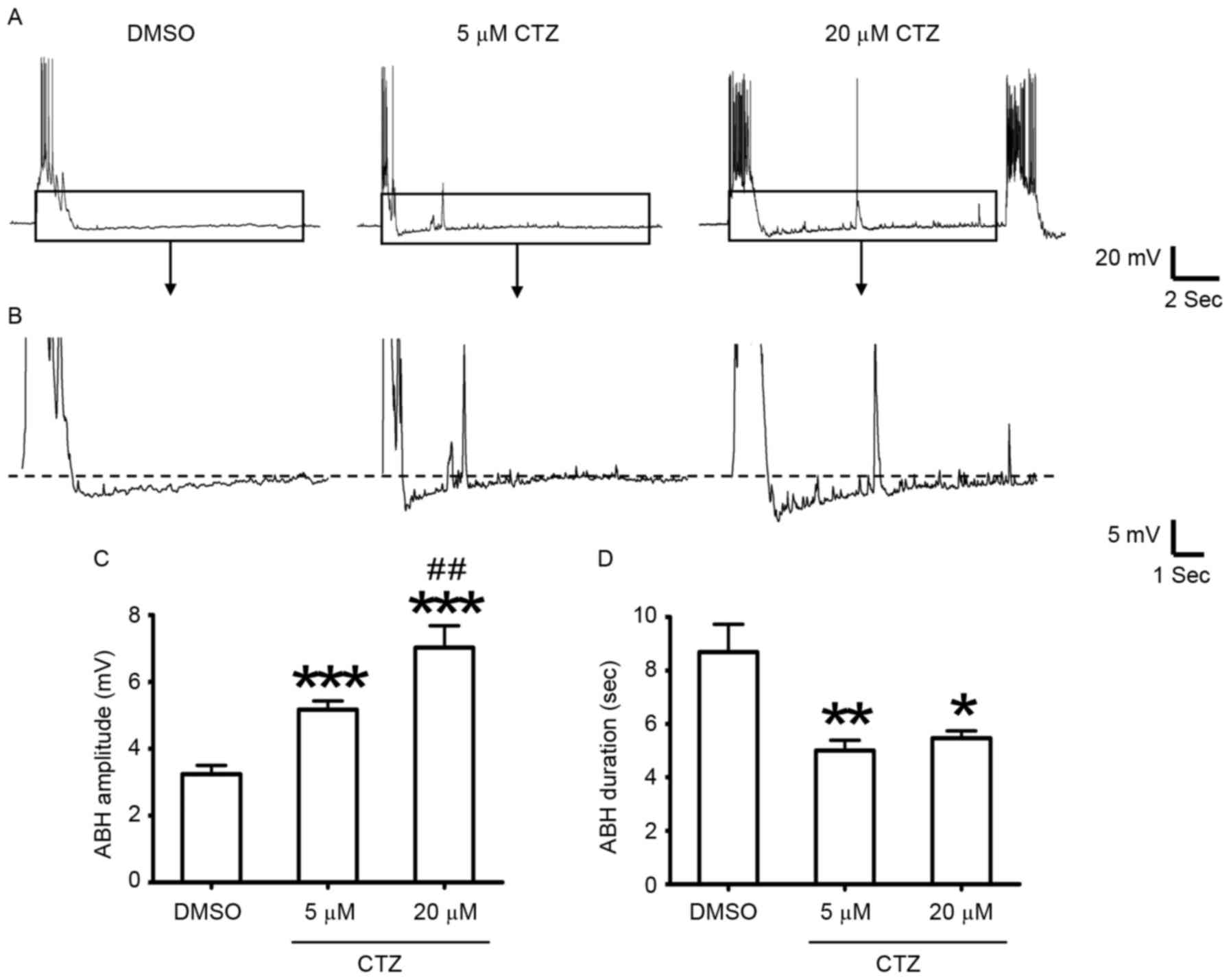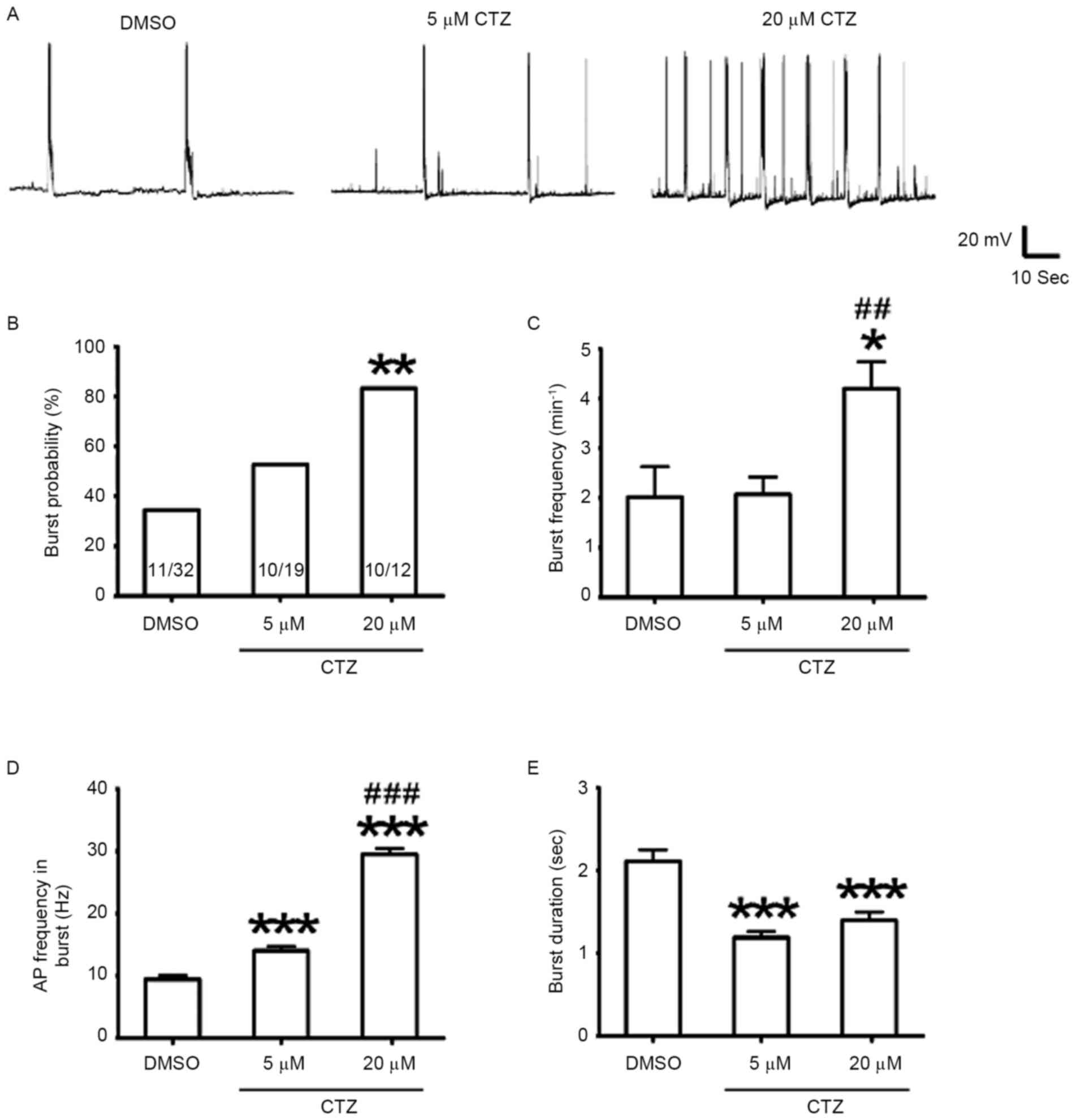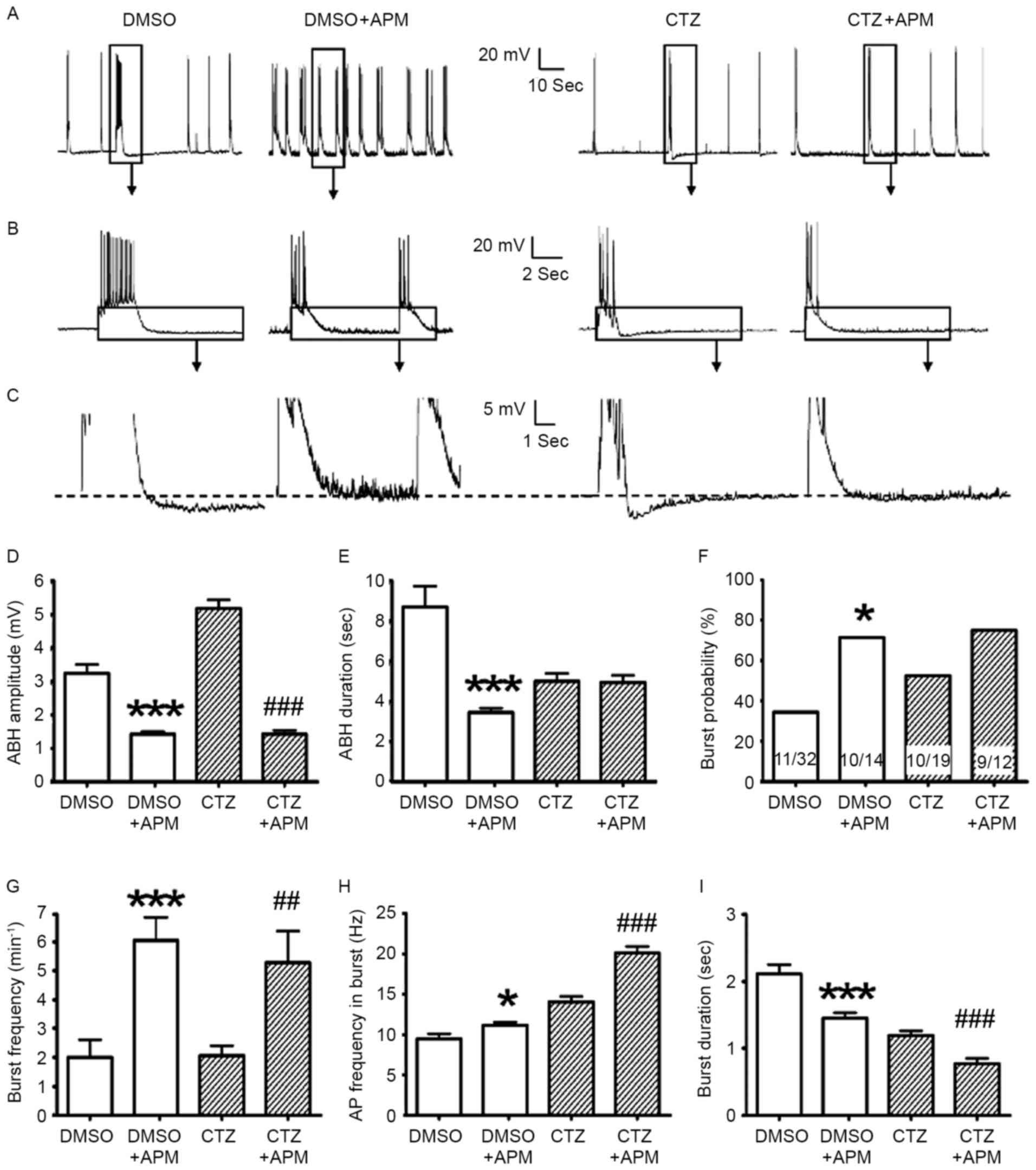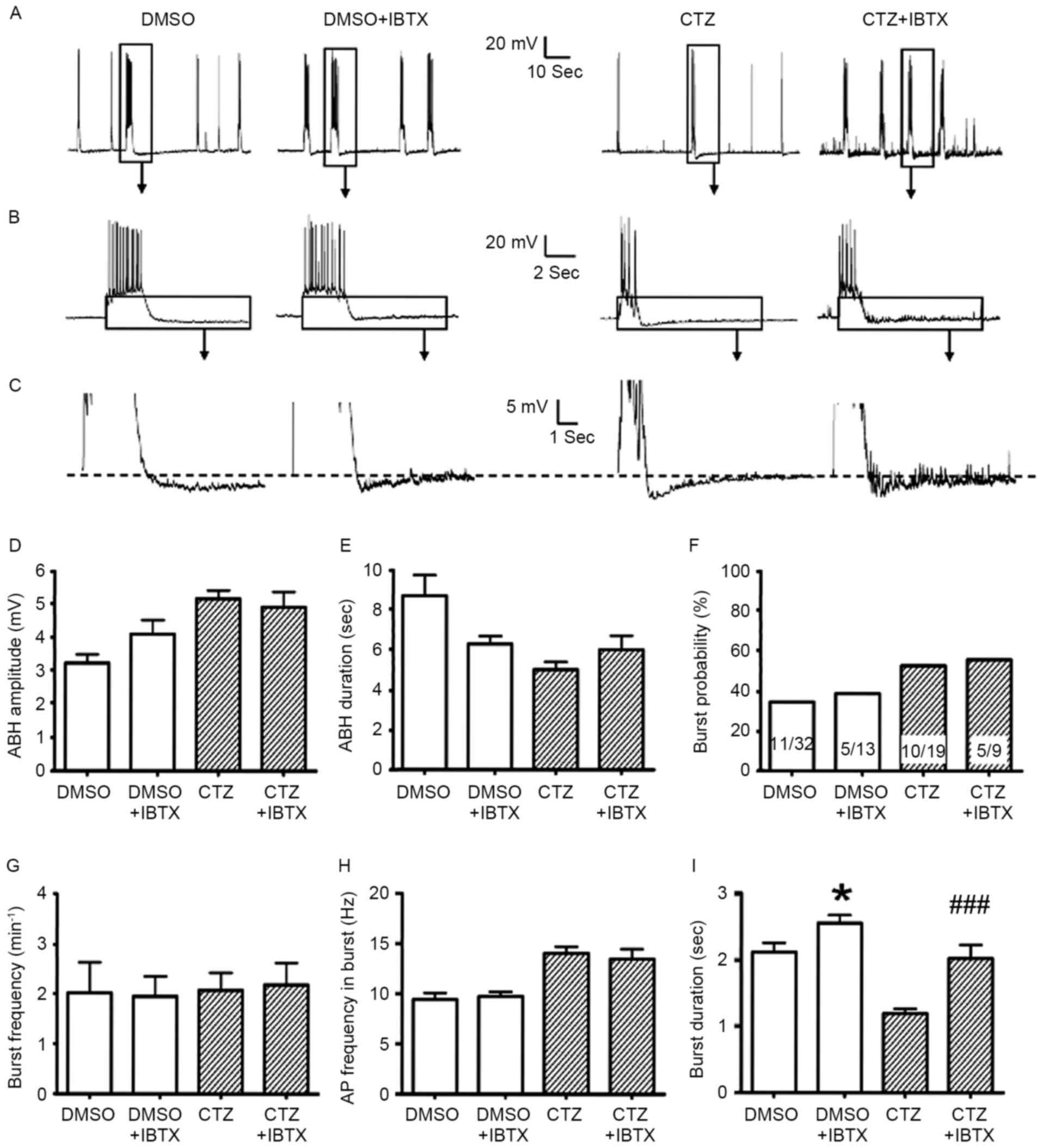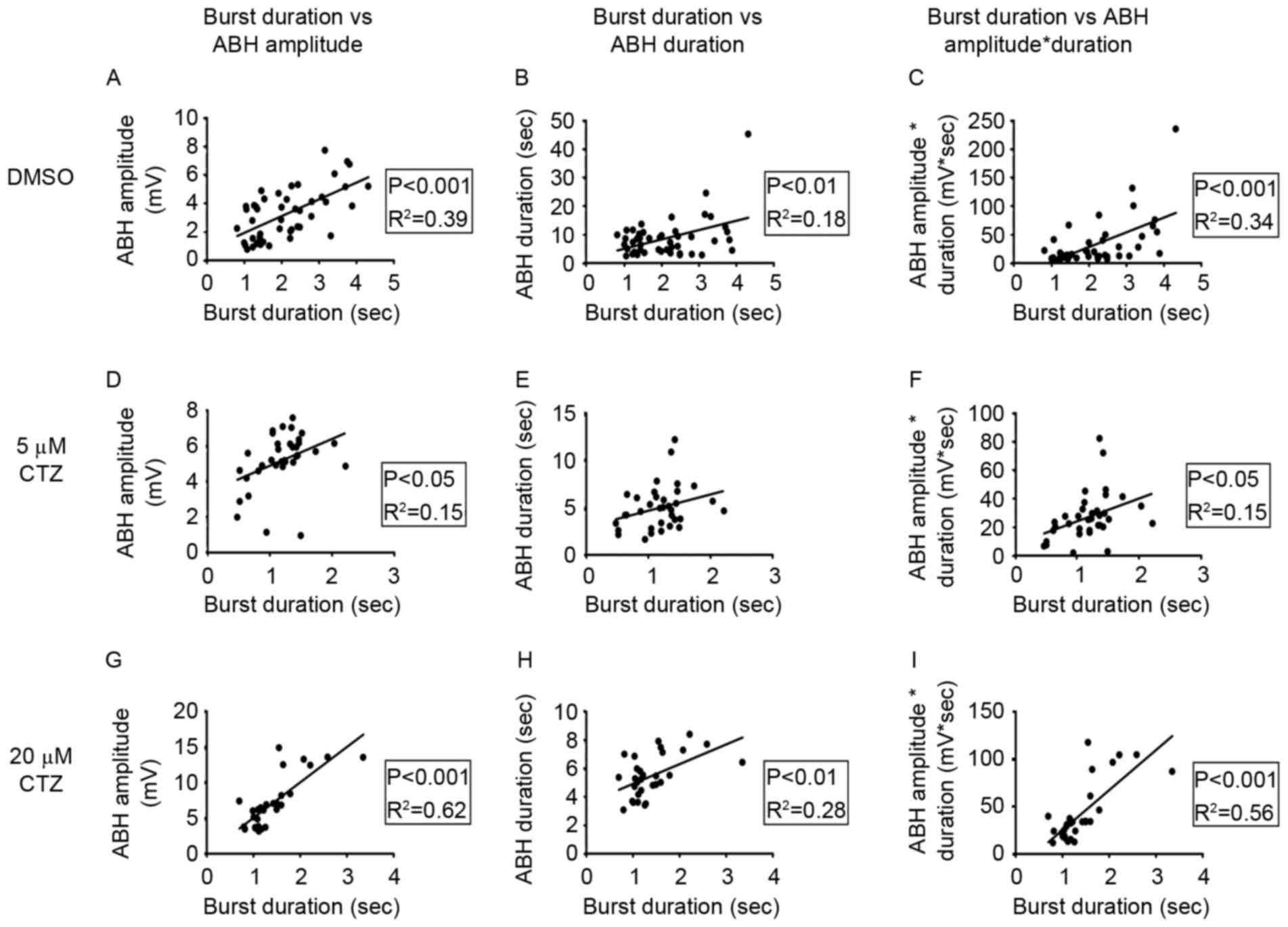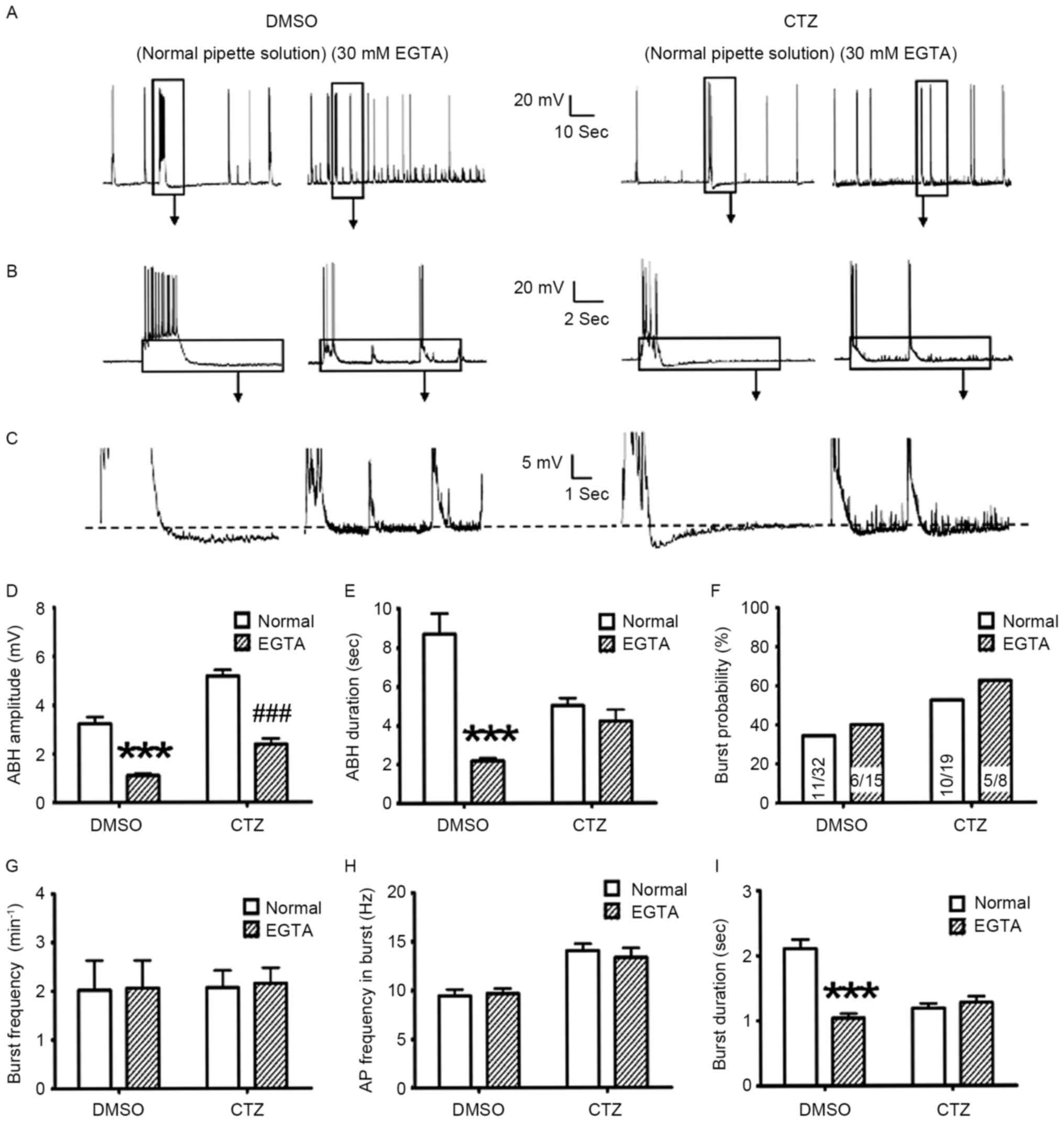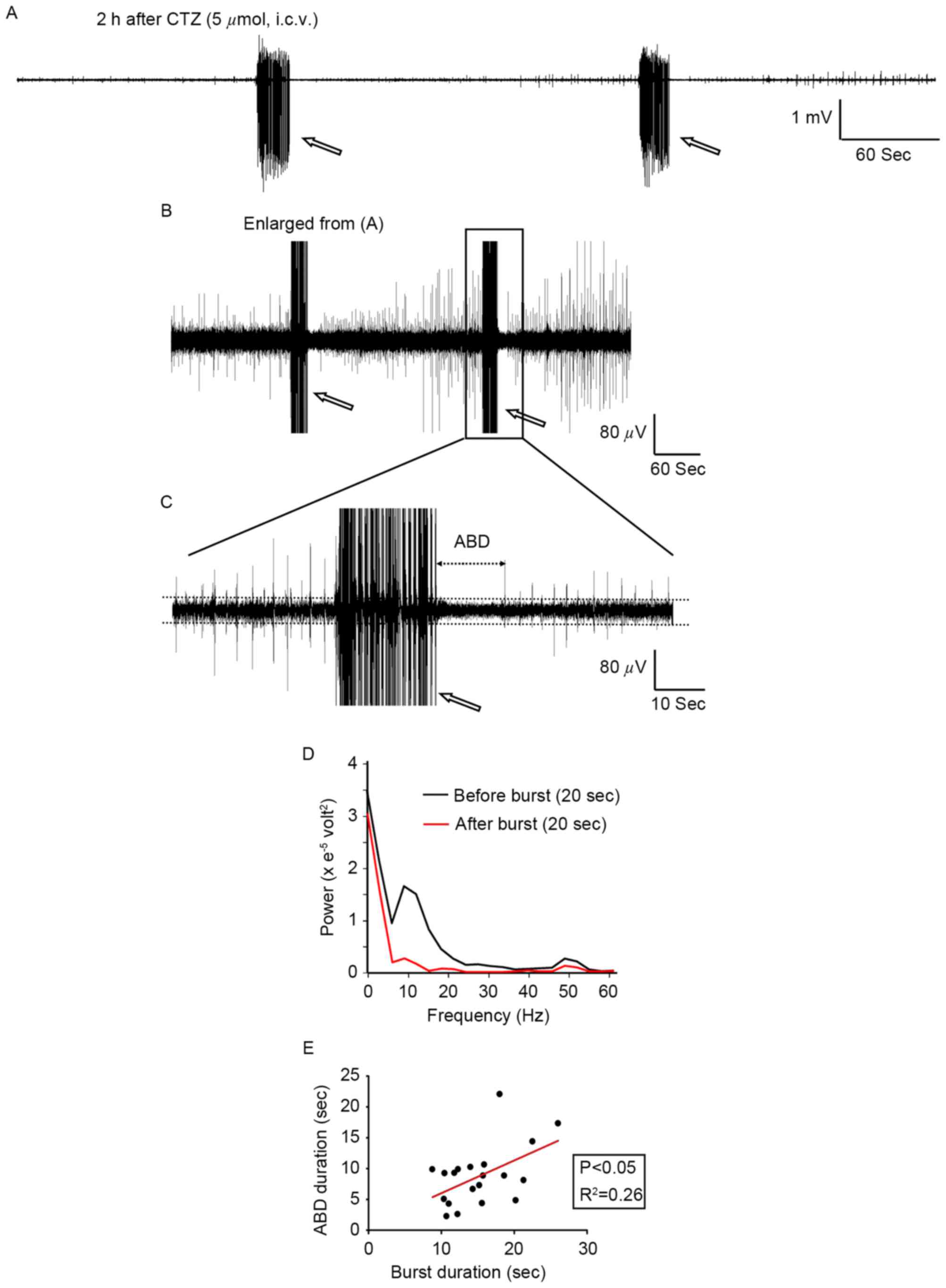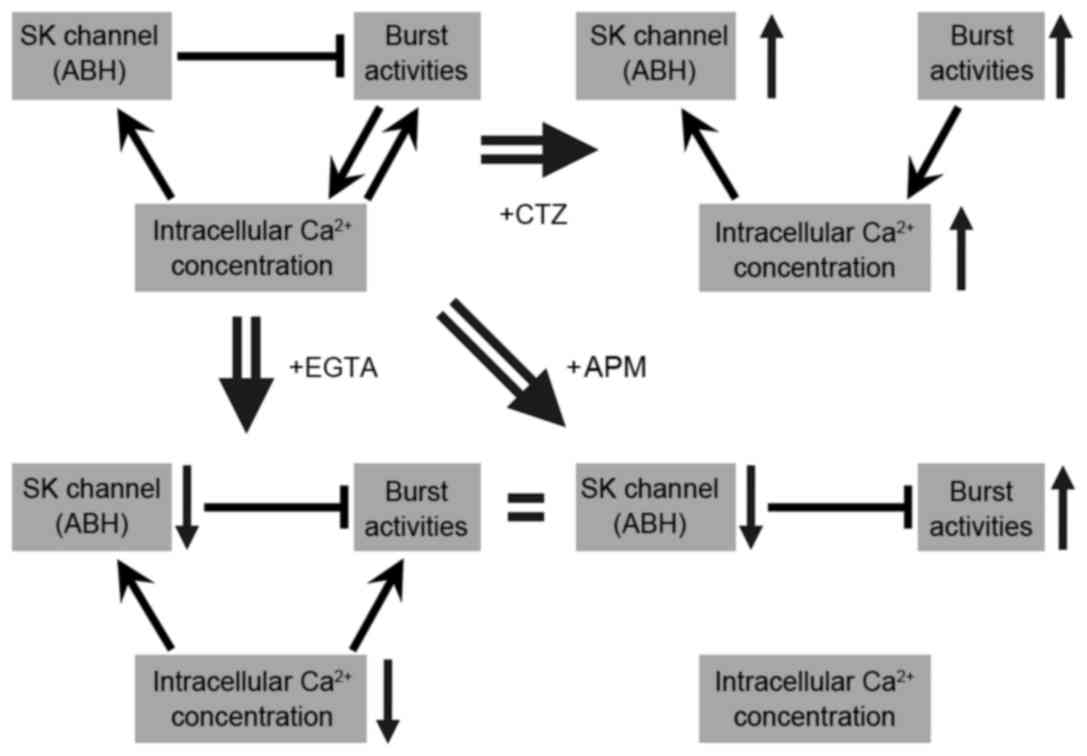|
1
|
Browne TR and Holmes GL: Epilepsy. N Engl
J Med. 344:1145–1151. 2001. View Article : Google Scholar
|
|
2
|
Lado FA and Moshé SL: How do seizures
stop? Epilepsia. 49:1651–1664. 2008. View Article : Google Scholar :
|
|
3
|
Ziemann AE, Schnizler MK, Albert GW,
Severson MA, Howard MA III, Welsh MJ and Wemmie JA: Seizure
termination by acidosis depends on ASIC1a. Nat Neurosci.
11:816–822. 2008. View
Article : Google Scholar :
|
|
4
|
Van Gompel JJ, Bower MR, Worrell GA, Stead
M, Chang SY, Goerss SJ, Kim I, Bennet KE, Meyer FB, Marsh WR, et
al: Increased cortical extracellular adenosine correlates with
seizure termination. Epilepsia. 55:233–244. 2014. View Article : Google Scholar :
|
|
5
|
Afra P, Jouny CC and Bergey GK:
Termination patterns of complex partial seizures: An intracranial
EEG study. Seizure. 32:9–15. 2015. View Article : Google Scholar :
|
|
6
|
Ferastraoaru V, Schulze-Bonhage A, Lipton
RB, Dümpelmann M, Legatt AD, Blumberg J and Haut SR: Termination of
seizure clusters is related to the duration of focal seizures.
Epilepsia. 57:889–895. 2016. View Article : Google Scholar
|
|
7
|
Mula M and Sander JW: Negative effects of
antiepileptic drugs on mood in patients with epilepsy. Drug Saf.
30:555–567. 2007. View Article : Google Scholar
|
|
8
|
Spencer SS and Spencer DD: Implications of
seizure termination location in temporal lobe epilepsy. Epilepsia.
37:455–458. 1996. View Article : Google Scholar
|
|
9
|
Bragin A, Penttonen M and Buzsáki G:
Termination of epileptic afterdischarge in the hippocampus. J
Neurosci. 17:2567–2579. 1997.
|
|
10
|
Alger BE and Nicoll RA: Epileptiform burst
afterhyperpolarization: Calcium-dependent potassium potential in
hippocampal CA1 pyramidal cells. Science. 210:1122–1124. 1980.
View Article : Google Scholar
|
|
11
|
Albowitz B, König P and Kuhnt U:
Spatiotemporal distribution of intracellular calcium transients
during epileptiform activity in guinea pig hippocampal slices. J
Neurophysiol. 77:491–501. 1997.
|
|
12
|
Vergara C, Latorre R, Marrion NV and
Adelman JP: Calcium-activated potassium channels. Curr Opin
Neurobiol. 8:321–329. 1998. View Article : Google Scholar
|
|
13
|
Zhang L and McBain CJ: Potassium
conductances underlying repolarization and after-hyperpolarization
in rat CA1 hippocampal interneurones. J Physiol. 488:661–672. 1995.
View Article : Google Scholar :
|
|
14
|
Xia XM, Fakler B, Rivard A, Wayman G,
Johnson-Pais T, Keen JE, Ishii T, Hirschberg B, Bond CT, Lutsenko
S, et al: Mechanism of calcium gating in small-conductance
calcium-activated potassium channels. Nature. 395:503–507. 1998.
View Article : Google Scholar
|
|
15
|
Faber ES and Sah P: Physiological role of
calcium-activated potassium currents in the rat lateral amygdala. J
Neurosci. 22:1618–1628. 2002.
|
|
16
|
Llinas R, Baker R and Sotelo C:
Electrotonic coupling between neurons in cat inferior olive. J
Neurophysiol. 37:560–571. 1974.
|
|
17
|
Auer RN: Progress review: Hypoglycemic
brain damage. Stroke. 17:699–708. 1986. View Article : Google Scholar
|
|
18
|
Oliveira MS, Skinner F, Arshadmansab MF,
Garcia I, Mello CF, Knaus HG, Ermolinsky BS, Otalora LF and
Garrido-Sanabria ER: Altered expression and function of
small-conductance (SK) Ca(2+)-activated K+ channels in
pilocarpine-treated epileptic rats. Brain Res. 1348:187–199. 2010.
View Article : Google Scholar :
|
|
19
|
Schulz R, Kirschstein T, Brehme H, Porath
K, Mikkat U and Köhling R: Network excitability in a model of
chronic temporal lobe epilepsy critically depends on SK
channel-mediated AHP currents. Neurobiol Dis. 45:337–347. 2012.
View Article : Google Scholar
|
|
20
|
Luján R, Maylie J and Adelman JP: New
sites of action for GIRK and SK channels. Nat Rev Neurosci.
10:475–480. 2009. View
Article : Google Scholar
|
|
21
|
Lappin SC, Dale TJ, Brown JT, Trezise DJ
and Davies CH: Activation of SK channels inhibits epileptiform
bursting in hippocampal CA3 neurons. Brain Res. 1065:37–46. 2005.
View Article : Google Scholar
|
|
22
|
Empson RM and Jefferys JG: Ca(2+) entry
through L-type Ca(2+) channels helps terminate epileptiform
activity by activation of a Ca(2+) dependent afterhyperpolarisation
in hippocampal CA3. Neuroscience. 102:297–306. 2001. View Article : Google Scholar
|
|
23
|
de Sevilla Fernández D, Garduño J, Galván
E and Buño W: Calcium-activated afterhyperpolarizations regulate
synchronization and timing of epileptiform bursts in hippocampal
CA3 pyramidal neurons. J Neurophysiol. 96:3028–3041. 2006.
View Article : Google Scholar
|
|
24
|
Qi J, Wang Y, Jiang M, Warren P and Chen
G: Cyclothiazide induces robust epileptiform activity in rat
hippocampal neurons both in vitro and in vivo. J Physiol.
571:605–618. 2006. View Article : Google Scholar :
|
|
25
|
Wang Y, Qi JS, Kong S, Sun Y, Fan J, Jiang
M and Chen G: BDNF-TrkB signaling pathway mediates the induction of
epileptiform activity induced by a convulsant drug cyclothiazide.
Neuropharmacology. 57:49–59. 2009. View Article : Google Scholar :
|
|
26
|
Deng L and Chen G: Cyclothiazide potently
inhibits gamma-aminobutyric acid type A receptors in addition to
enhancing glutamate responses. Proc Natl Acad Sci USA.
100:13025–13029. 2003. View Article : Google Scholar :
|
|
27
|
Kullmann DM and Semyanov A: Glutamatergic
modulation of GABAergic signaling among hippocampal interneurons:
Novel mechanisms regulating hippocampal excitability. Epilepsia. 43
Suppl 5:S174–S178. 2002. View Article : Google Scholar
|
|
28
|
Krishnan GP and Bazhenov M: Ionic dynamics
mediate spontaneous termination of seizures and postictal
depression state. J Neurosci. 31:8870–8882. 2011. View Article : Google Scholar :
|
|
29
|
Kong S, Qian B, Liu J, Fan M, Chen G and
Wang Y: Cyclothiazide induces seizure behavior in freely moving
rats. Brain Res. 1355:207–213. 2010. View Article : Google Scholar :
|
|
30
|
Qian B, Sun Y, Wu Z, Wan L, Chen L, Kong
S, Zhang B, Zhang F, Wang ZY and Wang Y: Epileptiform response of
CA1 neurones to convulsant stimulation by cyclothiazide, kainic
acid and pentylenetetrazol in anaesthetized rats. Seizure.
20:312–319. 2011. View Article : Google Scholar
|
|
31
|
Chen B, Jiang M, Zhou M, Chen L, Liu X,
Wang X and Wang Y: Both NMDA and non-NMDA receptors mediate
glutamate stimulation induced cofilin rod formation in cultured
hippocampal neurons. Brain Res. 1486:1–13. 2012. View Article : Google Scholar
|
|
32
|
Liu X, Chen B, Chen L, Ren WT, Liu J, Wang
G, Fan W, Wang X and Wang Y: U-shape suppressive effect of phenol
red on the epileptiform burst activity via activation of estrogen
receptors in primary hippocampal culture. PLoS One. 8:e601892013.
View Article : Google Scholar :
|
|
33
|
Chen L, Wan L, Wu Z, Ren W, Huang Y, Qian
B and Wang Y: KCC2 downregulation facilitates epileptic seizures.
Sci Rep. 7:1562017. View Article : Google Scholar :
|
|
34
|
Zhang Y, Huang Y, Liu X, Wang G, Wang X
and Wang Y: Estrogen suppresses epileptiform activity by enhancing
Kv4.2-mediated transient outward potassium currents in primary
hippocampal neurons. Int J Mol Med. 36:865–872. 2015. View Article : Google Scholar
|
|
35
|
Zhang Y, Huang Y, Wang G, Wang X and Wang
Y: Inhibition of 17-beta-estradiol on neuronal excitability via
enhancing GIRK1-mediated inwardly rectifying potassium currents and
GIRK1 expression. J Neurol Sci. 375:335–341. 2017. View Article : Google Scholar
|
|
36
|
Faber ESL and Sah P: Functions of SK
channels in central neurons. Clin Exp Pharmacol Physiol.
34:1077–1083. 2007. View Article : Google Scholar
|
|
37
|
Kleiman-Weiner M, Beenhakker MP, Segal WA
and Huguenard JR: Synergistic roles of GABAA receptors and SK
channels in regulating thalamocortical oscillations. J
Neurophysiol. 102:203–213. 2009. View Article : Google Scholar :
|
|
38
|
Schwartzkroin PA and Stafstrom CE: Effects
of EGTA on the calcium-activated afterhyperpolarization in
hippocampal CA3 pyramidal cells. Science. 210:1125–1126. 1980.
View Article : Google Scholar
|
|
39
|
Lancaster B and Adams PR:
Calcium-dependent current generating the afterhyperpolarization of
hippocampal neurons. J Neurophysiol. 55:1268–1282. 1986.
|
|
40
|
Abel HJ, Lee JC, Callaway JC and Foehring
RC: Relationships between intracellular calcium and
afterhyperpolarizations in neocortical pyramidal neurons. J
Neurophysiol. 91:324–335. 2004. View Article : Google Scholar
|
|
41
|
Scutt G, Allen M, Kemenes G and Yeoman M:
A switch in the mode of the sodium/calcium exchanger underlies an
age-related increase in the slow afterhyperpolarization. Neurobiol
Aging. 36:2838–2849. 2015. View Article : Google Scholar
|
|
42
|
Köhler M, Hirschberg B, Bond CT, Kinzie
JM, Marrion NV, Maylie J and Adelman JP: Small-conductance,
calcium-activated potassium channels from mammalian brain. Science.
273:1709–1714. 1996. View Article : Google Scholar
|
|
43
|
Stackman RW, Hammond RS, Linardatos E,
Gerlach A, Maylie J, Adelman JP and Tzounopoulos T: Small
conductance Ca2+-activated K+ channels modulate synaptic plasticity
and memory encoding. J Neurosci. 22:10163–10171. 2002.
|
|
44
|
Pedarzani P, Mosbacher J, Rivard A,
Cingolani LA, Oliver D, Stocker M, Adelman JP and Fakler B: Control
of electrical activity in central neurons by modulating the gating
of small conductance Ca2+-activated K+ channels. J Biol Chem.
276:9762–9769. 2001. View Article : Google Scholar
|
|
45
|
Anderson NJ, Slough S and Watson WP: In
vivo characterisation of the small-conductance KCa (SK) channel
activator 1-ethyl-2-benzimidazolinone (1-EBIO) as a potential
anticonvulsant. Eur J Pharmacol. 546:48–53. 2006. View Article : Google Scholar
|
|
46
|
Kernig K, Kirschstein T, Würdemann T,
Rohde M and Köhling R: The afterhyperpolarizing potential following
a train of action potentials is suppressed in an acute epilepsy
model in the rat Cornu Ammonis 1 area. Neuroscience. 201:288–296.
2012. View Article : Google Scholar
|
|
47
|
Beck H, Clusmann H, Kral T, Schramm J,
Heinemann U and Elger CE: Potassium currents in acutely isolated
human hippocampal dentate granule cells. J Physiol. 498:73–85.
1997. View Article : Google Scholar :
|
|
48
|
Garduño J, Galván E, de Sevilla Fernández
D and Buño W: 1-Ethyl-2-benzimidazolinone (EBIO) suppresses
epileptiform activity in in vitro hippocampus. Neuropharmacology.
49:376–388. 2005. View Article : Google Scholar
|















